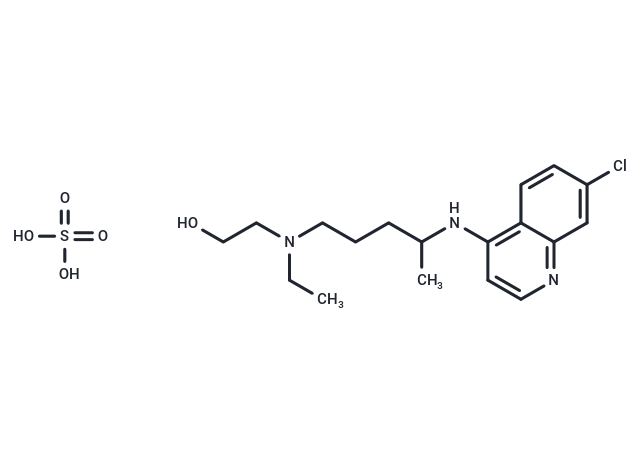Shopping Cart
- Remove All
 Your shopping cart is currently empty
Your shopping cart is currently empty

Hydroxychloroquine sulfate (Acidum iopanoicum) inhibits plasmodial heme polymerase. It is a chemotherapeutic agent that acts against erythrocytic forms of malarial parasites. Hydroxychloroquine appears to concentrate in food vacuoles of affected protozoa.

| Pack Size | Price | Availability | Quantity |
|---|---|---|---|
| 50 mg | $48 | In Stock | |
| 100 mg | $74 | In Stock |
| Description | Hydroxychloroquine sulfate (Acidum iopanoicum) inhibits plasmodial heme polymerase. It is a chemotherapeutic agent that acts against erythrocytic forms of malarial parasites. Hydroxychloroquine appears to concentrate in food vacuoles of affected protozoa. |
| In vitro | Hydroxychloroquine Sulfate is a potent inhibitor of autophagy. It prevents lysosomal acidification, thereby interfering with a key step in the autophagic process.HCQ treatment inhibits RCC (renal cell cancer) cell growth, promotes apoptosis, inhibits mitochondrial oxygen consumption, and increases rates of glycolysis[2]. |
| In vivo | The treatment of Hydroxychloroquine Sulfate reduces the infarct size in an in vivo rat model of I/R injury and the cardioprotective effect of Hydroxychloroquine is ERK1/2 dependent[3]. In addition, Hydroxychloroquine Sulfate shows an early vascular protective effect. HCQ seems to prevent the occurrence of endothelial dysfunction(ED) in treated animals[4]. |
| Kinase Assay | In vitro kinase assays: with purified proteins, recombinant S6 protein and recombinant active P70S6K are incubated in 1x kinase buffer with various amount of HCQ or RAD001 in the presence (25 μM) or absence of ATP for 30 minutes at 30°C. Total and phosphorylated S6 at ser235/236 and ser240/244 are detected by western analysis using phosphospecific antibodies. Note that recombinant GST-tagged S6 (53 kd) is distinguished from endogenous S6 (32 kd) on the western blot. |
| Cell Research | All cells are cultured in RPMI with 10% FBS, 1% glutamine, and 1% Pen/Strep. cells are seeded on the appropriated plates overnight and treated with HCQ (75 or 100 μM) for 48 hours.(Only for Reference) |
| Alias | HCQ sulfate, Acidum iopanoicum |
| Molecular Weight | 433.95 |
| Formula | C18H26ClN3O·H2SO4 |
| Cas No. | 747-36-4 |
| Smiles | OS(=O)(=O)O.CCN(CCO)CCCC(C)Nc1c2ccc(Cl)cc2ncc1 |
| Relative Density. | no data available |
| Storage | Powder: -20°C for 3 years | In solvent: -80°C for 1 year | Shipping with blue ice. | ||||||||||||||||||||
| Solubility Information | DMSO: Insoluble H2O: 10 mM, Sonication is recommended. | ||||||||||||||||||||
Solution Preparation Table | |||||||||||||||||||||
H2O
| |||||||||||||||||||||

Copyright © 2015-2025 TargetMol Chemicals Inc. All Rights Reserved.